
24 Jul Blighia sapida
Scientific name: Blighia sapida K.D Koenig.
Family: Sapindaceae.
Distribution/conservation status: widespread and relatively common, extending from evergreen forest into savanna but most abundant in welldrained areas of semi-deciduous forest. It is also planted to improve soil fertility and control erosion, for production of edible arils, seed oil, and medicinal parts, and as an ornamental. Not assessed by the IUCN Red List.
Common names: Akee apple, Savory akee tree (English), Okpu (Igbo), Isin (Yoruba), Ukpe (Edo).
Fruits/seeds: leathery, pear shaped, 3-lobed capsule containing 3 hard, shiny black seeds, each embedded in a cream-coloured fleshy aril.
Fruiting time: March – September.
Seed collection: when ripe, fruits break open to expose seeds which dangle from threads. Collect fruits directly from the tree or from the ground underneath the parent tree. Discard any fruits or seeds which are damaged or starting to dry.
Type of seed: recalcitrant.
Sowing method: sow seeds flat in nursery pots at a depth of 3cm.
Sowing medium: forest soil.
Germination period: 7 – 10 days.
Germination percentage: 80 – 85%.
Growth/development: seedlings grow best in partial shade but saplings should be planted in full sunlight. Trees are fast-growing initially; flowering starts after five years and fruiting after 7 years.
Notes: seeds should be sown within a few days after collection as they lose viability if stored. Seedlings require regular watering. Avoid areas prone to flooding or waterlogging when planting out.

Blighia sapida fruiting

